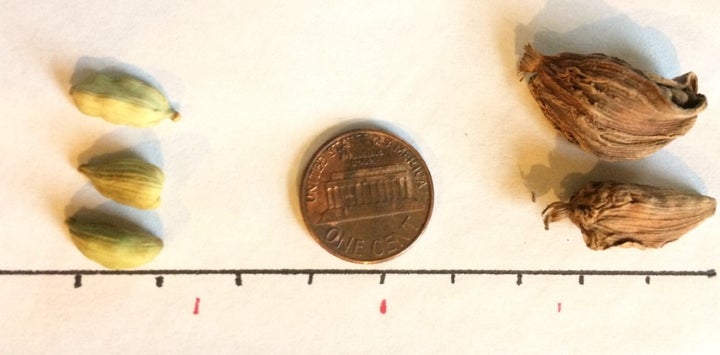Tropical spices have been used in traditional medicine for centuries. Cardamom, the third most expensive spice* in the world, is a reservoir of compounds that alleviate a variety of physiological discomforts.

The recent pathetic self-congratulatory tone of the House Republicans with regards to their attempts to fashion a new healthcare act, is hopefully short-lived. In addition to potential procedural hurdles that the bill will likely face in the Senate, Republican senators have already expressed concern over language in parts of the bill. If the Senate passes a bill that is substantially different from the one passed by the House, then the bill would likely have to go back to the House. Historically, about 3% of bills introduced in Congress are enacted into law. The trajectory of the Affordable Care Act can be found at govtrack.us and is shown below [Note: the site is an independent site, and not a government site — it tracks bills and provides statistical analyses of legislation]. From the time of introduction of the bill, September 17, 2009, to it being approved by both the Senate and the House on March 20, 2010, Congress had convened for a total of 90 days.

The current bill, H.R. 1628: American Health Care Act of 2017, will at the very least go through a similar process, which means the earliest we could see it enacted into law could be September 2017. From all indications, if it passes, the new healthcare act will have imposed severe restrictions on access to healthcare for innumerable citizens. In times of scarcity, people typically resort to alternative solutions and it’s conceivable that scarce access to healthcare will be no different.
The past to the fore
In 2015, Marijke Van der Veen, and Jacob Morales from the University of Leicester reported their findings from studying botanical remains recovered during archaeological excavations at Quseir al-Qadim, located on the Red Sea coast of Egypt. Quseir al-Qadim was active as a transport hub during both Roman (ca. AD 1–250, when it was known as Myos Hormos), and Islamic periods (ca. AD 1050–1500, when it was known as Kusayr). The excavations, conducted between 1999 and 2003, revealed at least seven tropical spices including black pepper, ginger, cardamom, turmeric. Based on texts from those periods, it appears these spices were traded for rituals, perfumery, medicinal use, and cooking. Of these, ginger, cardamom and turmeric belong to the family Zingiberaceae — the ginger family. [Note: biological classification has many tiers and can be conceptualized as a triangle with its apex at the bottom. The main hierarchy puts species at the apex, with genus before it, and family before genus. This is not unlike zooming out of your house on a map — the most detailed picture would give the coordinates of your house — this would be the species equivalent; the less detailed picture would give you the city in which your house exists — this would be the genus equivalent; and a still less detailed picture would give the state in which your house exists — this would be the family equivalent. Thus, the scientific name for the ginger root you buy at the grocery store Zingiberaceae Zingiber officinale. Typically, only the genus and species names are used together — the family name is not always included.]
Family ties
The Zingiberaceae family has at least 50 genera (genera is the plural of genus), and more than 1600 species. Turmeric, cardamom, and ginger are three of the 1600 species and their origin has been traced back to India. The Quseir al-Qadim excavations also confirm this based on the trade routes in both the Roman and Islamic periods, and historic texts.
Turmeric, cardamom, and ginger while primarily used as spices in traditional Indian cooking, have also been used in traditional medicine to address different ailments. While there have been recent reports in the popular press about the medicinal properties of turmeric and ginger, much less attention has been given to cardamom. This skewed public interest is illustrated in Google Trends, below.

Turmeric (blue), ginger (red) and cardamom (yellow) as search terms since 2004
Elettaria cardamomum, more commonly known as cardamom or green cardamom or true cardamom is distinct from brown/black cardamom — Amomum subulatum, although in the early 19th century they were incorrectly considered to be the same genus. The genus name ‘Elettaria’ comes from the local Indian name for the plant, indigenous to the southwestern part of the Indian peninsula. The 1899 publication of the The United States Dispensatory and Physicians’ Pharmacology, provides a description of the cardamom plant and states that “This valuable plant is a native of the mountains of Malabar, where it springs up spontaneously in the forests after the removal of the undergrowth, and is very extensively cultivated by the natives…..The odor of cardamom is fragrant, the taste warm, slightly pungent, and highly aromatic…The seeds should be powdered only when wanted for use, as they retain their aromatic properties best while in the capsule.” While India used to be the world’s largest producer of green cardamom, that position now belongs to Guatemala.

Scale in centimeters (black) and inches (red) to compare two species of cardamom - green, and brown/black, with a US penny also as a size reference.
Spice of life
The chemical composition, and therefore the flavor, aroma, and biochemical properties of green cardamom and brown/black cardamom are distinct. The limited scientific literature available is more specific to green cardamom, which continues to be the more expensive of the two, and sells for about $35 per pound in the pod. While the shell is also aromatic, the seeds are the primary source of the aromatic components — volatile oils and other phytochemicals — by some estimates up to 150 unique components. Because of centuries of anecdotal evidence on the medicinal properties of green cardamom in humans, there have now been a few reports on studies in laboratory animals in order to determine the active principles conferring the medicinal properties. Perhaps the most convincing ones are related to the analgesic and antispasmodic effects of oil extracted from the seeds. In fact, a closer look at the chemical composition of cardamom oil suggests that one of the primary components of the oil has the ability to relax smooth muscles, effectively reducing, if even modestly, some types of gastric discomfort. It is perhaps for this reason that crushed cardamom is an essential component of “masala chai” (masala=spice; chai=tea), spiced tea now sold well beyond Indian shores, and for a hefty price!
The NIH, whose funding is also on 45’s chopping block, had initiated a program on complementary medicine in 2005, because it recognized that “People have used complementary and alternative medicine (CAM) practices for thousands of years in pursuit of health and well-being.” But with looming budget cuts for the NIH, it is unclear how these programs will will be affected. Citizens will thus be doubly robbed of health — once through a lopsided healthcare law, and again by reducing funding to healthcare research. One wonders how trading in commodities will be affected as a consequence— particularly as it relates to members of the Zingiberaceae family!
*Saffron is the most expensive spice, followed by vanilla — cost being normalized to weight.
